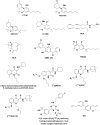Targeting Cannabinoid CB2 Receptors in the Central Nervous System. Medicinal Chemistry Approaches with Focus on Neurodegenerative Disorders
- PMID: 27679556
- PMCID: PMC5020102
- DOI: 10.3389/fnins.2016.00406
Targeting Cannabinoid CB2 Receptors in the Central Nervous System. Medicinal Chemistry Approaches with Focus on Neurodegenerative Disorders
Abstract
Endocannabinoids activate two types of specific G-protein-coupled receptors (GPCRs), namely cannabinoid CB1 and CB2. Contrary to the psychotropic actions of agonists of CB1 receptors, and serious side effects of the selective antagonists of this receptor, drugs acting on CB2 receptors appear as promising drugs to combat CNS diseases (Parkinson's disease, Huntington's chorea, cerebellar ataxia, amyotrohic lateral sclerosis). Differential localization of CB2 receptors in neural cell types and upregulation in neuroinflammation are keys to understand the therapeutic potential in inter alia diseases that imply progressive neurodegeneration. Medicinal chemistry approaches are now engaged to develop imaging tools to map receptors in the living human brain, to develop more efficacious agonists, and to investigate the possibility to develop allosteric modulators.
Keywords: GPCR; M0/M1/M2 phenotype; amyotrophic lateral sclerosis; astroglia; heteromer; microglia; neuroprotection; neurorestoration.
Figures


References
Publication types
LinkOut - more resources
Full Text Sources
Other Literature Sources

